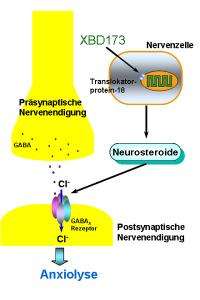New mechanisms of action found for drugs used to treat anxiety disorders

(PhysOrg.com) -- In the course of his or her life, every seventh German will develop an anxiety disorder that will require treatment. Standard anti-anxiety medications (anxiolytics) are based on the benzodiazepine class of drugs. These calm the patient and quickly diminish feelings of anxiety.
However, undesirable side effects like tiredness, drug intolerance and withdrawal problems make the long-term use of these drugs problematic. Scientists working under Rainer Rupprecht, Fellow of the Max Planck Institute of Psychiatry in Munich, succeeded in proving, for the first time, that new anxiolytics can be developed using an innovative mechanism based on neurosteroids derived from the hormone progesterone. This kind of drug displayed significantly fewer side effects, both in the animal tests and in a clinical trial. (Science Express, June 18, 2009)
A patient may be suffering from an anxiety disorder if he or she experiences feelings of anxiety that exceed the normal level and there is no identifiable cause of these feelings. Those affected by such disorders usually suffer considerably, both in their private and professional lives. In addition to psychotherapy and anti-depressives, which take a long time to take effect, benzodiazepines can usually alleviate the fear quickly and in the short term. However, these drugs can have considerable side effects if taken over longer periods, including, for example, the development of tolerance, dependence and withdrawal symptoms.
As part of their quest for new mechanisms of action for anti-depressives and anxiolytics, Florian Holsboer and Rainer Rupprecht at the Max Planck Institute of Psychiatry in Munich have been researching for years how neurosteroids influence the neuronal communication in the brain. They examined the effect of a new class of substances in co-operation with the Department of Psychiatry of the Ludwig-Maximilians-Universität Munich and the Novartis pharmaceutical concern in Basel. The substance in question, XBD173, had a positive influence on the synthesis of the body’s neurosteroids and, as the scientists were able to prove with the help of mouse brain tissue, triggered the attenuation of neuronal communication as a result. XBD173 also displayed an anxiolytic effect on the behavioural level in the animal model without observing any sedating effects that arise, for example, with benzodiazepines. "I am absolutely delighted that the hypothesis we developed years ago, that anxiolytic effects can be attained by influencing the body’s neurosteroids, has been scientifically confirmed today," says Florian Holsboer in response to this latest finding.
In order to test the effect of XBD173 in humans for the first time, the doctors designed a clinical trial, in which 70 healthy volunteer subjects were tested. The subjects were injected with the neuropeptide fragment CCK-4, which triggered a short anxiety and panic attack lasting two to five minutes. When XBD173 was also administered to the subjects, the panic attack could not be triggered in this way. The benzodiazepine Alprazolam also curbed feelings of anxiety. However, in contrast to XBD173, the participants in the trial reported undesired fatigue on taking the drug and withdrawal symptoms on its discontinuation.
Thus, through the stimulation of neurosteroid synthesis using the translocator protein 18, the researchers discovered a new mechanism for the treatment of anxiety disorders that displays a better side-effect profile than benzodiazepine. In addition, the conditions were defined under which such studies can be carried out on healthy subjects. "The successful implementation of an experimentally inducible anxiety model in healthy subjects will facilitate the development of innovative anxiolytics in the future, as the testing of active ingredients in their early phase of development does not necessarily have to be carried out on patients," says Rainer Rupprecht. He is, however, aware that insights gained on healthy subjects cannot necessarily be transferred to patients on a 1:1 basis. "They do not replace the necessary acceptance tests on patient groups."
More information: Translocator Protein (18 kDa) as Target for Anxiolytics without Benzodiazepine-Like Side Effects
Science (2009), Online-prepublication Science Express June 18, 2009
Provided by Max Planck Institute















